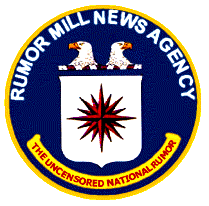ON THE FRONT PAGE OF TODAY'S, 8-17-01, WALL STREET JOURNAL:
WASHINGTON -- The Pentagon has fixed its sights on buying the domestic version of the Stars and Stripes, the venerable servicemen's newspaper that folded in June.
The question is: Why?
The military hasn't decided to resume publication of the paper. Instead, it has made it clear it wants only the Stars and Stripes name.
"Essentially what's happening is the government is buying a private publication to shut it down," says former Managing Editor Mickey McCarter, who oversaw Stars and Stripes news coverage.
But former newspaper staffers as well as some readers point instead to a number of recent, critical articles on the Pentagon's anthrax vaccination program as a source of government ire. The newspaper has reported that the vaccine, part of an effort to inoculate troops against biological warfare, causes debilitating illness in some recipients.
Full text follows:
August 17, 2001
Politics & Policy
Pentagon Targets Stars and Stripes,
Leaving Ex-Staffers to Wonder Why
By VASUGI GANESHANANTHAN
Staff Reporter of THE WALL STREET JOURNAL
WASHINGTON -- The Pentagon has fixed its sights on buying the domestic version of the Stars and Stripes, the venerable servicemen's newspaper that folded in June.
The question is: Why?
The military hasn't decided to resume publication of the paper. Instead, it has made it clear it wants only the Stars and Stripes name, says Jack Colletti, chief executive officer of Stars & Stripes Omnimedia Inc., which bought the paper a year ago but has just filed for Chapter 7 liquidation in U.S. Bankruptcy Court. While the Stars and Stripes is published privately in the U.S., the Pentagon has used the same name for its own overseas publications for nearly 60 years, and now says it wants to end confusion about who owns what version.
But former Stars and Stripes staffers, who hold out hope the biweekly domestic paper will be restarted, see it differently. The Pentagon's ultimate goal, they believe, is to silence the critical coverage the domestic paper has sometimes offered its readers. "Essentially what's happening is the government is buying a private publication to shut it down," says former Managing Editor Mickey McCarter, who oversaw Stars and Stripes news coverage.
The familiar Stars and Stripes brand name, on display in these past editions, is at the center of a bidding tug of war.
Pentagon spokesman Bryan Whitman disputes that, saying the Defense Department has been negotiating with Stars and Stripes Omnimedia over the trademark since May 2000. Before the filing, the department had submitted a bid believed to be more than twice an earlier offer made by Ogden Newspapers Inc., a West Virginia publisher. The Stars and Stripes staff favored the Ogden offer, which hasn't been disclosed, because the publishing firm intended to resume printing the paper.
Neither Mr. Whitman nor Mr. Colletti would comment on the specifics of the bids.
The Stars and Stripes boasts a storied history that has become more complicated in recent years. It began as a newspaper put out by Union troops in the Civil War. Decades later, after the paper drifted in and out of existence, ex-staffers banded together to start the private publication, the predecessor of today's domestic version.
During World War II, though, the government and the paper agreed that the Pentagon could use the same name for overseas publications -- the European and Pacific editions -- that were put out by the Defense Department. Mr. Whitman contends that the current power of the brand rests with those government-sponsored overseas editions. For decades, the government and various private owners have wrangled over how to settle the trademark confusion. But Mr. Whitman doesn't know of any previous government bids to buy the paper outright.
It's on the market now, as its dot-com parent feels the heat. Stars & Stripes Omnimedia, formerly iserved.com, is being liquidated. Raji Sankar, a co-founder of Stars and Stripes Omnimedia, says the newspaper wasn't profitable, even before her company took it over last year.
With the Stars and Stripes assets up for sale, the Pentagon saw a chance to end the name dispute once and for all, Mr. Whitman says. But former newspaper staffers as well as some readers point instead to a number of recent, critical articles on the Pentagon's anthrax vaccination program as a source of government ire. The newspaper has reported that the vaccine, part of an effort to inoculate troops against biological warfare, causes debilitating illness in some recipients.
"My question would be: Why has the Pentagon chosen this time to clear up any problems in the identity of the Stars and Stripes brand? It seems an unusual coincidence," says retired Air Force Reserve Col. John Richardson, who has been involved in antivaccine efforts.
Mr. Colletti says that shutting the paper down was purely a financial decision. All told, Mr. Colletti says, the company had received bids ranging from $200,000 to $1 million before the bankruptcy filing. He won't name specific buyers, but says he had bidders interested in purchasing the newspaper regardless of whether it retained its historic name. "Right now there's 20,000 paying subscribers waiting for their newspaper to come in the mail," he says. "I don't think they're going to stop subscribing because of the name change."
But Ogden Newspapers CEO Robert Nutting says the hiatus in publication already makes it difficult to relaunch, and without the Stars and Stripes name, Ogden isn't interested in the newspaper. "We viewed it as a brand with tremendous history and a publication that was on the rebound," he says.
Howard Haugerud, chairman of National Tribune Corp., which sold Stars and Stripes to iserved.com a year ago for $100,000, dates the trouble back to 1942 when National Tribune orally agreed to let the government use the name for its European and Pacific editions.
An arrangement that seemed to work so well during wartime deteriorated significantly in 1977, when the Pentagon began selling advertising, Mr. Haugerud says. That, he adds, cut deeply into the domestic edition's revenue because it confused advertisers who thought they were automatically buying space in the U.S. paper. In fact, the paper wasn't profitable after 1977.
Mr. Haugerud, a former assistant secretary of State and Defense Department employee, puts the total revenue lost at about $100 million over the past two decades. "All it is, is a name," he says. "The only thing that sold that paper at all was the name."
But there is little the former staff members can do. First Amendment media lawyer Floyd Abrams says the Department of Defense's move is legal. However, he says, "If the purpose is to avoid confusion, there must be some other way to do that other than stifling the speech of an entity that exists in good part to cover the Pentagon."
--------------------------------------------------------------------------------
URL for this Article:
http://interactive.wsj.com/archive/retrieve.cgi?id=SB99799510192256907.djm






































